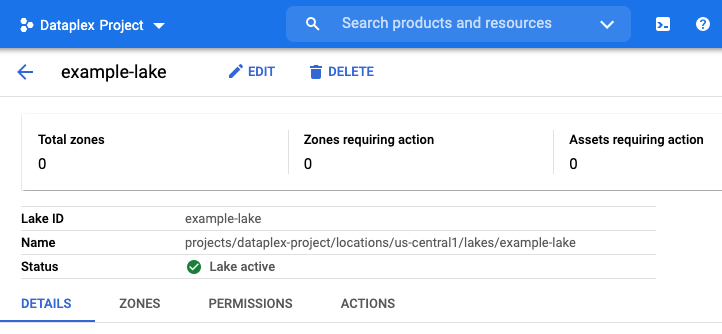Nesta página, explicamos como visualizar, atualizar e excluir um lake do Universal Catalog do Dataplex.
Antes de começar
- Se ainda não tiver feito isso, crie um lake.
Funções exigidas
Para atualizar um lake, você precisa receber o papel do IAM que contém a permissão
dataplex.lakes.create. Por exemplo, o papel de administrador do Dataplex (roles/dataplex.admin) ou editor do Dataplexroles/dataplex.editordo IAM.Para excluir um lake, você precisa receber um papel do IAM que contenha a permissão
dataplex.lakes.delete. Por exemplo, o papel de administrador do Dataplex (roles/dataplex.admin) ou editor do Dataplex (roles/dataplex.editor) do IAM.
Também é possível conceder permissões de atualização e exclusão a usuários ou grupos
usando os papéis legados roles/owner e roles/editor.
Para mais informações, consulte Controle de acesso do Dataplex Universal Catalog com o IAM.
Ver um lake
Para conferir seu lake do Dataplex Universal Catalog no console do Google Cloud , siga estas etapas:
Acesse a página Lakes do Dataplex Universal Catalog.
Clique no nome do lake que você quer ver.

Opcional: para gerenciar as zonas de dados atuais no seu lake ou adicionar novas, clique na guia Zonas. Para mais informações, consulte Como gerenciar uma zona.
Opcional: para conferir detalhes do data lake, como o número de itens de dados descobertos e os recursos no data lake, clique na guia Detalhes.
Opcional: para gerenciar as permissões do lake, clique na guia Permissões. Saiba mais em Controle de acesso com o IAM.
Opcional: para ver ações no nível do data lake, especificamente problemas relacionados à propagação da política de segurança, clique na guia Ações.
Confira ações no nível do lake, especificamente problemas relacionados à propagação da política de segurança. Para mais informações, consulte Descobrir dados.
Atualizar um lake
Apenas um job de atualização é compatível por vez, e cada job pode ter várias atualizações de propriedade. Você ainda pode usar o lago enquanto ele estiver sendo atualizado.
É possível atualizar os seguintes parâmetros do data lake:
- Nome
- Descrição
- Rótulos
Para atualizar um lake, siga estas etapas:
Console
No console Google Cloud , acesse a página Lakes do Universal Catalog do Dataplex.
Na página Lakes, clique no nome do lake que você quer atualizar. A página do lake é aberta.
Clique em Editar. A página Editar Lake é aberta.
Escolha os valores de parâmetro de lago atualizados.
Clique no botão Salvar para atualizar o lake.
Verifique se você retornou para a página Lakes e se o lake atualizado aparece na lista.
REST
Para atualizar um lake, use o método lakes.patch.
Quando a atualização é bem-sucedida, o lake entra automaticamente no estado ativo. Se ele falhar, o lake será revertido para o estado íntegro anterior.
Excluir um lake
Você poderá excluir o lake se as configurações estiverem incorretas e não puderem ser alteradas.
Não é possível excluir um lake até que todos os recursos da zona de dados abaixo dele sejam excluídos. Da mesma forma, não é possível excluir uma zona de dados até que todos os recursos de ativos nela sejam excluídos. Os usuários que tiverem acesso a dados por meio desses lakes ou zonas de dados perderão os direitos de acesso.
Console
No console Google Cloud , acesse a página Lakes do Universal Catalog do Dataplex:
Na página Lakes, clique no nome do lake que você quer excluir. A página do lake é aberta.
Clique em Excluir. A caixa de diálogo Excluir lake é aberta.
Para confirmar a exclusão, digite
delete.Clique em Excluir Lake.
Verifique se você retornou para a página Lagos e se o lago excluído não aparece mais na lista.
REST
Para excluir um lake, use o método lakes.delete.
A exclusão pode levar algum tempo.
A seguir
- Saiba como gerenciar uma zona.
- Saiba como gerenciar e anexar buckets.
- Saiba mais sobre os registros de auditoria do Cloud.

